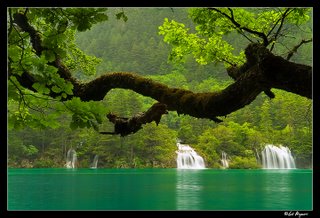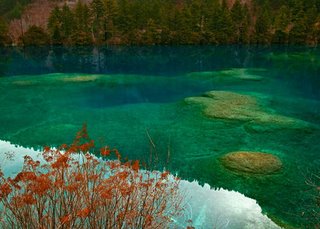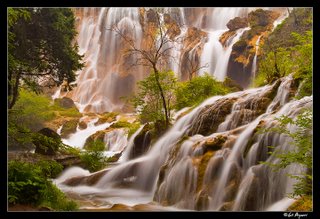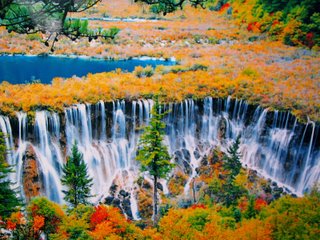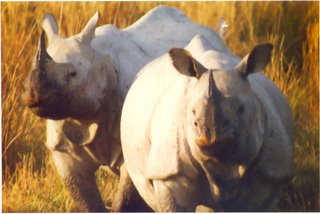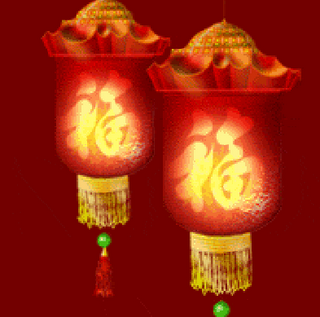 The Spring Festival is the largest and most important festival in China. It is the first day of the lunar calendar and usually occurs somewhere between January 30 and February 20, heralding the beginning of spring, thus it is known as Spring Festival. This traditional festival is also a festival of reunion; no matter how far away people are from their homes, they will try their best to get back to have the Reunion Dinner.
The Spring Festival is the largest and most important festival in China. It is the first day of the lunar calendar and usually occurs somewhere between January 30 and February 20, heralding the beginning of spring, thus it is known as Spring Festival. This traditional festival is also a festival of reunion; no matter how far away people are from their homes, they will try their best to get back to have the Reunion Dinner.The Chinese meaning of this festival is Guo Nian. Guo means "pass over" and Nian means "year." The origin of the Chinese New Year Festival can be traced back thousands of years through a continually evolving series of colorful legends and traditions. According to one of the most famous legends, in ancient China there lived a horned monster named Nian who was extremely ferocious. Nian lived deep at the bottom of the sea all the year round and climbed up to the shore only on New Year's Eve to devour the cattle and kill people.Thereupon on the day of every New Year's Eve people from all villages would flee, bringing along the old and the young, to the remote mountains so as to avoid the calamity caused by the monster Nian. Then, one New Year's Eve, the people of Peach Blossom village were getting ready to hide when there came from outside the village an old beggar with a stick in his hand and a bag hanging upon his arm. His eyes twinkled like stars and his beard was silver.Seized with panic, the villagers were in a great hurry to run away. Some were closing the windows and locking the doors, some were packing, and others were urging the cattle and driving the sheep. At a time when the people were shouting and the horses were neighing no one was in the mood to care for the beggar.Only a grandmother living in the east end of the village gave the old man some food and advised him to flee to the mountains to avoid the monster. But the old man stroked his beard and said with a smile, "If you allow me to stay at your home for the night, I'm sure to drive away the monster Nian.The old woman was surprised to hear this. She looked at him unbelievingly only to find that, with white hair and ruddy complexion, the old man had a bearing out of the ordinary. She went on to persuade him to take flight. But he only smiled without reply. Thereupon the grandmother could not help but leave her home and flee to the mountains.Around midnight the monster Nian rushed into the villages. He found the atmosphere was quite different from that of the previous year. The house of the grandmother in the east end of the village was brilliantly illuminated, with bright red paper stuck on the doors. Greatly shocked, the monster gave a strange loud cry.The monster Nian stared angrily at the house for a moment then, howling furiously, made a charge at it. As he approached the door, there suddenly came the sounds of explosions. Trembling all over, the monster dared not take a step forward.It turned out that the color red, flames, and explosions were what Nian feared the most. And when the door of the grandmother's house was thrown open and an old man in a red robe burst out laughing in the courtyard, the monster Nian was scared out of his wits and fled helter-skelter.The next day was the 1st of the first lunar month. When people came back from their hideouts and found everything safe and sound, they were quite surprised. The old woman suddenly realized what had happened and told the villagers about the old beggar's promise.The villagers swarmed into the grandmother's house, only to find that the doors were covered with red paper, the embers from a pile of bamboo were still giving out exploding sounds in the courtyard, and a few candles were still glowing in the room.The story was soon spread far and wide and everybody was talking about it. They concluded in the end that the old beggar was surely the celestial being who came to expel the calamities and bless the people, and that red paper, red cloth, red candles, and the exploding firecracker were certainly the magic weapons to drive out the monster Nian.To celebrate the arrival of such good luck, the elated villagers put on their clothes and new hats and went one after another to their relatives and friends to send their regards and congratulations. This was soon spread to the surrounding villages, and people all got to know the way to drive away the monster Nian.
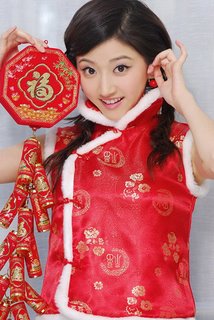 From then on, on each New Year's Eve, each family sticks on their doors antithetical couplets written on red paper, blows up firecrackers, keeps their houses brilliantly illuminated and stays up late into the night. Early in the morning of the 1st of the first lunar month they go to their relatives and friends' homes to send their regards and congratulations. These customs have been passed down through the generations, making it the most ceremonious traditional festival of the Chinese people.Spring Festival which is also called Chinese New Year falls on January, 1st, according to the Chinese lunar calendar. It is usually called as Yinlinian. This is the most important festival in China. It originated in Shang DynastyWhen Spring Festival comes, spring comes as well. Everything comes to life and plants are prosperous. Just having experienced a cold winter, people are so excited to welcome a new spring.The warm atmosphere is not only in the houses, but also in the streets. In many places, lion dances and dragon lantern show are performed during Spring Festival. In some places, people kept the customs of Shehuo performance, visiting flower market, going to the temple fair. During this period, the cities are full of lanterns and the streets are crowded with people. Activities last to the 15th of January, this can be an end of Spring Festival.People in different places celebrate Spring Festival in different ways. Generally speaking, a Chinese family will hold a Spring Festival feast, light firecracker and give lucky money to children during Spring Festival. See details of Chinese New Year Celebration (Spring Festival).
From then on, on each New Year's Eve, each family sticks on their doors antithetical couplets written on red paper, blows up firecrackers, keeps their houses brilliantly illuminated and stays up late into the night. Early in the morning of the 1st of the first lunar month they go to their relatives and friends' homes to send their regards and congratulations. These customs have been passed down through the generations, making it the most ceremonious traditional festival of the Chinese people.Spring Festival which is also called Chinese New Year falls on January, 1st, according to the Chinese lunar calendar. It is usually called as Yinlinian. This is the most important festival in China. It originated in Shang DynastyWhen Spring Festival comes, spring comes as well. Everything comes to life and plants are prosperous. Just having experienced a cold winter, people are so excited to welcome a new spring.The warm atmosphere is not only in the houses, but also in the streets. In many places, lion dances and dragon lantern show are performed during Spring Festival. In some places, people kept the customs of Shehuo performance, visiting flower market, going to the temple fair. During this period, the cities are full of lanterns and the streets are crowded with people. Activities last to the 15th of January, this can be an end of Spring Festival.People in different places celebrate Spring Festival in different ways. Generally speaking, a Chinese family will hold a Spring Festival feast, light firecracker and give lucky money to children during Spring Festival. See details of Chinese New Year Celebration (Spring Festival).
More China festivals...
 From then on, on each New Year's Eve, each family sticks on their doors antithetical couplets written on red paper, blows up firecrackers, keeps their houses brilliantly illuminated and stays up late into the night. Early in the morning of the 1st of the first lunar month they go to their relatives and friends' homes to send their regards and congratulations. These customs have been passed down through the generations, making it the most ceremonious traditional festival of the Chinese people.Spring Festival which is also called Chinese New Year falls on January, 1st, according to the Chinese lunar calendar. It is usually called as Yinlinian. This is the most important festival in China. It originated in Shang DynastyWhen Spring Festival comes, spring comes as well. Everything comes to life and plants are prosperous. Just having experienced a cold winter, people are so excited to welcome a new spring.The warm atmosphere is not only in the houses, but also in the streets. In many places, lion dances and dragon lantern show are performed during Spring Festival. In some places, people kept the customs of Shehuo performance, visiting flower market, going to the temple fair. During this period, the cities are full of lanterns and the streets are crowded with people. Activities last to the 15th of January, this can be an end of Spring Festival.People in different places celebrate Spring Festival in different ways. Generally speaking, a Chinese family will hold a Spring Festival feast, light firecracker and give lucky money to children during Spring Festival. See details of Chinese New Year Celebration (Spring Festival).
From then on, on each New Year's Eve, each family sticks on their doors antithetical couplets written on red paper, blows up firecrackers, keeps their houses brilliantly illuminated and stays up late into the night. Early in the morning of the 1st of the first lunar month they go to their relatives and friends' homes to send their regards and congratulations. These customs have been passed down through the generations, making it the most ceremonious traditional festival of the Chinese people.Spring Festival which is also called Chinese New Year falls on January, 1st, according to the Chinese lunar calendar. It is usually called as Yinlinian. This is the most important festival in China. It originated in Shang DynastyWhen Spring Festival comes, spring comes as well. Everything comes to life and plants are prosperous. Just having experienced a cold winter, people are so excited to welcome a new spring.The warm atmosphere is not only in the houses, but also in the streets. In many places, lion dances and dragon lantern show are performed during Spring Festival. In some places, people kept the customs of Shehuo performance, visiting flower market, going to the temple fair. During this period, the cities are full of lanterns and the streets are crowded with people. Activities last to the 15th of January, this can be an end of Spring Festival.People in different places celebrate Spring Festival in different ways. Generally speaking, a Chinese family will hold a Spring Festival feast, light firecracker and give lucky money to children during Spring Festival. See details of Chinese New Year Celebration (Spring Festival).More China festivals...
